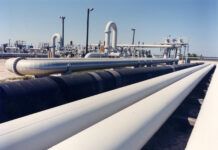All signs point to greater stability in the deepwater Gulf of Mexico. In the last four years, the rig count has increased by some 30 rigs, and the most recent lease sale on March 21 generated $244 million in high bids, representing a gradual upward trend since 2017.
Shell was the biggest overall spender in the latest sale, with Equinor submitting the highest single bid at $24.5 million. “(The) lease sale shows strong bidding by established companies, which indicates that the Gulf of Mexico will continue to be a leading energy source for our nation long into the future,” says Joe Balash, assistant secretary for land and minerals management, U.S. Department of the Interior, in a press release.
There are other positive signs in the Gulf: BP announced a $1.3 billion expansion in January following the discovery of an additional 400 million barrels of oil in the Atlantis field. The investment will fund a subsea production system running from eight new wells to its current platform some 150 miles south of New Orleans. BP expects the platform to be operational by 2020, adding another 38,000 barrels to the company’s daily production capacity.
But not all the news is good. The number of players in the annual lease sales continues to thin, with the notable recent absence of ExxonMobil. And given the high barrier to entry in the offshore market, most midsized players are excluded from the game.
“The (BP announcement) exemplifies the long-term viability of the Gulf, but it doesn’t change the fact that offshore oil is a high-stakes poker game,” says David Dismukes, executive director of LSU’s Center for Energy Studies. “And not a lot of people play at the high-stakes table.”
Offshore likely will remain an expensive proposition, as current market dynamics aren’t enticing enough to pull producers away from the shale plays. As such, the cards are stacked heavily in favor of the mega-producers who can find innovative ways to get more out of their existing Gulf structures. BP uses its own proprietary algorithm that allows seismic imaging data to be processed in a matter of weeks instead of a year.
“That technology isn’t widely available to a lot of players in that industry,” Dismukes says. “They can’t take advantage of it. They don’t have the balance sheets. It takes a BP or Shell or Chevron to do that. Your average cost is the cost divided by output, and the more you can increase that denominator the more you can drive down that number.”
Gifford Briggs, president of the Louisiana Oil & Gas Association, says shifting public opinion and a variety of governmental hurdles following the Deepwater Horizon disaster have further hindered offshore development and prompted companies to shift their strategies to the Permian Basin and other shale plays.
This has, in turn, significantly impacted those companies that service the industry.









